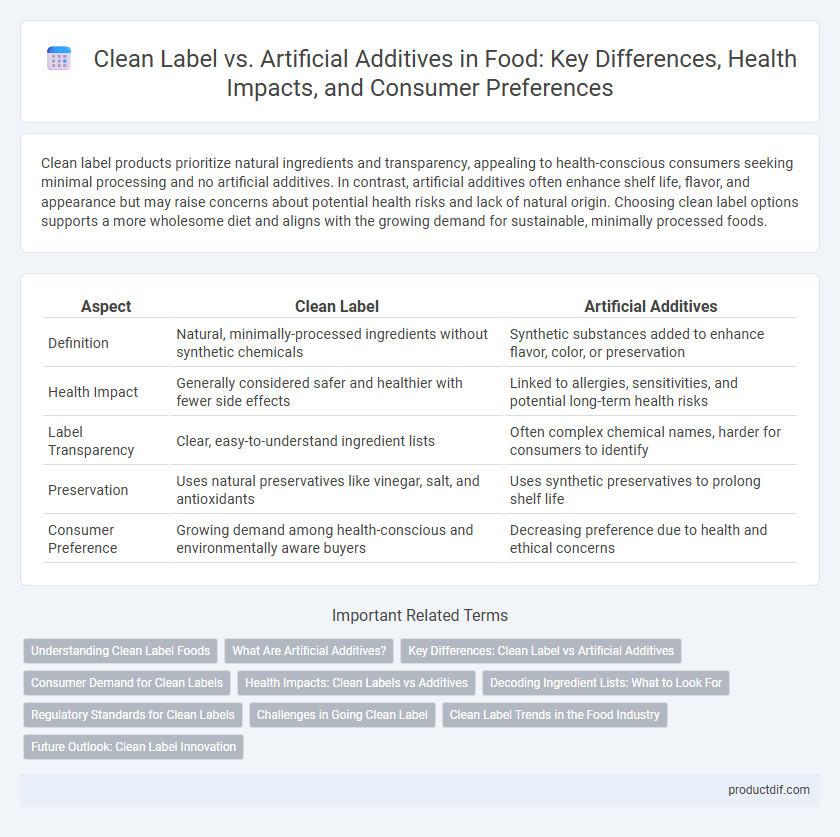Clean label products prioritize natural ingredients and transparency, appealing to health-conscious consumers seeking minimal processing and no artificial additives. In contrast, artificial additives often enhance shelf life, flavor, and appearance but may raise concerns about potential health risks and lack of natural origin. Choosing clean label options supports a more wholesome diet and aligns with the growing demand for sustainable, minimally processed foods.
Table of Comparison
| Aspect | Clean Label | Artificial Additives |
|---|---|---|
| Definition | Natural, minimally-processed ingredients without synthetic chemicals | Synthetic substances added to enhance flavor, color, or preservation |
| Health Impact | Generally considered safer and healthier with fewer side effects | Linked to allergies, sensitivities, and potential long-term health risks |
| Label Transparency | Clear, easy-to-understand ingredient lists | Often complex chemical names, harder for consumers to identify |
| Preservation | Uses natural preservatives like vinegar, salt, and antioxidants | Uses synthetic preservatives to prolong shelf life |
| Consumer Preference | Growing demand among health-conscious and environmentally aware buyers | Decreasing preference due to health and ethical concerns |
Understanding Clean Label Foods
Clean label foods emphasize transparency and simplicity in ingredients, avoiding artificial additives such as synthetic preservatives, colors, and flavor enhancers. Consumers increasingly seek products with natural, recognizable components like organic grains, real fruit extracts, and minimal processing techniques. This trend reflects a growing demand for healthier, safer food choices that promote trust and align with clean eating principles.
What Are Artificial Additives?
Artificial additives are synthetic substances added to food products to enhance flavor, color, texture, or shelf life. Common types include preservatives like sodium benzoate, artificial colors such as tartrazine, and flavor enhancers like monosodium glutamate (MSG). These additives are often scrutinized for potential health effects, leading to increased consumer demand for clean label alternatives free from synthetic chemicals.
Key Differences: Clean Label vs Artificial Additives
Clean label products emphasize natural, recognizable ingredients free from synthetic chemicals, appealing to health-conscious consumers seeking transparency in food sourcing. Artificial additives often include synthetic preservatives, colorants, and flavor enhancers designed to prolong shelf life and improve taste but may raise concerns about potential health risks. The key differences lie in ingredient origin, consumer perception, and regulatory scrutiny, with clean label trends driving innovation toward minimally processed foods with straightforward ingredient lists.
Consumer Demand for Clean Labels
Consumer demand for clean label foods is rapidly increasing as shoppers seek transparency, natural ingredients, and minimal processing in their products. Clean label products avoid artificial additives, synthetic preservatives, and chemical colorants, appealing to health-conscious and environmentally aware consumers. This trend drives food manufacturers to reformulate recipes and prioritize organic, non-GMO, and recognizable ingredients to meet evolving market expectations.
Health Impacts: Clean Labels vs Additives
Clean label foods emphasize natural ingredients, reducing exposure to synthetic preservatives and artificial colorings linked to potential allergic reactions and long-term health risks. Artificial additives, such as high-fructose corn syrup and synthetic emulsifiers, have been associated with inflammation, digestive issues, and metabolic disorders in various studies. Choosing clean label products supports better overall health by minimizing chemical intake and promoting more transparent ingredient sourcing.
Decoding Ingredient Lists: What to Look For
When decoding ingredient lists, prioritize recognizable components like natural spices, whole foods, and simple preservatives such as ascorbic acid or tocopherols, which align with clean label standards. Avoid ingredients with complex chemical names like sodium benzoate or artificial colorants such as FD&C Red No. 40, commonly associated with artificial additives. Understanding these distinctions helps consumers choose products with transparent, health-conscious formulations and fewer synthetic substances.
Regulatory Standards for Clean Labels
Regulatory standards for clean labels emphasize transparency and strict ingredient criteria, ensuring foods contain recognizable, minimally processed components without synthetic additives. Agencies like the FDA and EFSA enforce guidelines requiring clear disclosure of natural ingredients while limiting the use of artificial preservatives, colors, and flavors. Compliance with these regulations supports consumer trust and aligns with the growing demand for clean label products in the food industry.
Challenges in Going Clean Label
Transitioning to clean label formulations presents challenges such as maintaining product shelf life, texture, and flavor without synthetic preservatives and artificial additives. Manufacturers must identify natural alternatives that meet regulatory standards while ensuring consumer safety and satisfaction. High sourcing costs and variability of natural ingredients also complicate consistent production and scalability.
Clean Label Trends in the Food Industry
Clean label trends in the food industry emphasize transparency, natural ingredients, and minimal processing to meet consumer demand for healthier options. Brands increasingly replace artificial additives with plant-based preservatives, natural flavors, and organic ingredients to boost product appeal and trust. Market research shows a 12% annual growth in clean label product launches, reflecting a shift toward sustainable and wellness-focused food choices.
Future Outlook: Clean Label Innovation
Clean label innovation is driving the future of the food industry by prioritizing transparency, natural ingredients, and consumer trust. Advances in plant-based preservatives, natural antioxidants, and enzyme technology enable manufacturers to replace artificial additives while maintaining product quality and shelf life. This shift aligns with rising consumer demand for health-conscious, minimally processed foods and supports sustainable sourcing initiatives.
Clean Label vs Artificial Additives Infographic

 productdif.com
productdif.com